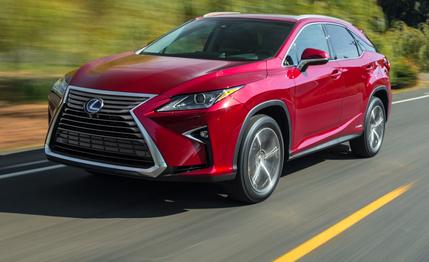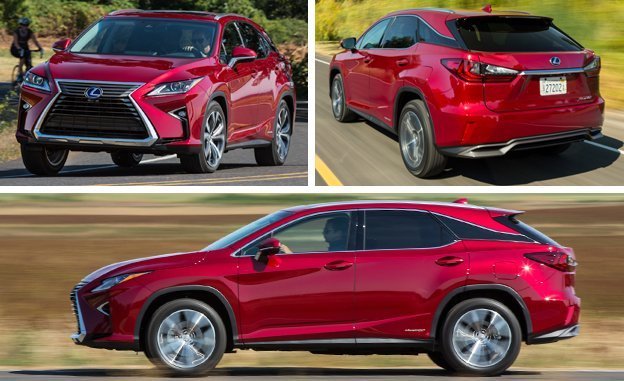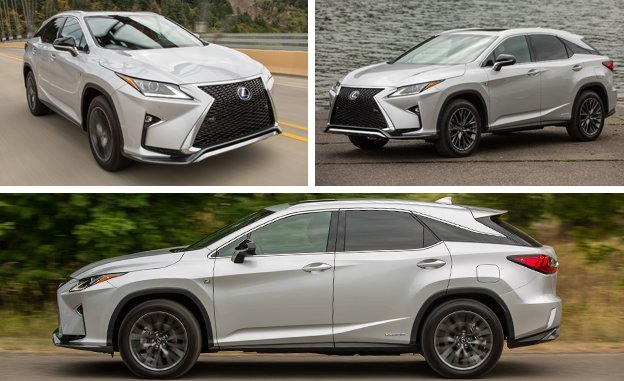 First Drive Review
First Drive Review
It is a truism of the movie industry that every model wants to act, actors inevitably want to direct, and directors really aspire to be producers. The restlessness that propels the players in Hollywood to abandon what they do well in favor of doing something different seems at times also to affect the auto industry. Take the Lexus RX. Launched in 1998, its dossier includes a crowd-pleasing combination of virtues: plush environs, a cosseting ride, an elevated seating position, a modicum of versatility, and all-weather capability. Far and away the brand’s bestselling vehicle, the RX boasts “legions of repeat buyers,” according to Lexus chief Mark Templin. Given all that, you might think that with the all-new, fourth-generation RX, Lexus would be satisfied to build on the vehicle’s strengths.
Instead, Lexus casts an envious eye toward BMW—which, paradoxically, has been making its cars more Lexus-like in recent years. Lexus wants the new RX to be seen as edgier, sportier, more youthful, more masculine—more akin to the X5, you might say. In the words of marketing boss Brian Bolain, “Lexus is not satisfied representing only rational attributes.”
Thus, the styling. Even more so than the RC coupe, the NX compact ute, and the latest GS sedan, the new RX exterior is a riot of acute angles and slanted creases. The pinched grille flares dramatically outward toward the bottom, and a blacked-out section of the C-pillar gives the appearance of a floating roof. The high beams, low beams, and taillights are LEDs; a standalone option adds LED driving lights and rear turn signals (but not the cool, sequential rear turn signals other markets get). The available 20-inch wheels come in two designs, including one that offers a choice of four different inset color treatments. Thanks mostly to the new styling, overall length is 4.7 inches greater, while the height and wheelbase have increased by 1.4 and 1.9 inches; width is about the same.
Inside, the push to add visual interest took a more tasteful turn. Hard plastics have been almost completely banished, contrast stitching is widely employed, new color treatments include red and dark brown, and a 12-inch center display is available (an eight-inch unit is standard). The dash top is lower and the A-pillars slimmer, which aids forward visibility. Base vehicles get a central, rotary controller but with navigation comes the mouselike Remote Touch unit, which is slightly less awkward to use now that it adds Enter buttons on its sides; other buttons call up the map, go back, and zoom. Just to the right, a knob switches among the standard drive modes: Eco, Normal, and Sport, which are joined by Sport+ in the F Sport and EV mode in the RX450h.

The hybrid’s powertrain again combines a 3.5-liter V-6 and an electric motor (AWD hybrids add a second electric motor to power the rear wheels). Preliminary estimates from Lexus have the front-drive version clocking in at 31/30 mpg, which is a slight decrease in the city figure but an increase in the highway number compared with the 2015 model. The all-wheel-drive hybrid is expected to return the same 30/28 mpg as before. Although the recent swoon in gas prices has dampened demand for the RX450h, those who do go for the hybrid will find the system more transparent than before. Brake feel, in particular, is improved. Total system output is up slightly, from 295 to 308 horsepower, and despite the CVT, throttle response is fairly normal.
An RX200t, with the 2.0-liter turbo four from the IS and NX, is available in other markets but we won’t get it. Instead, our mainstay engine is once again a 3.5-liter V-6. The six has all the polish you’d expect, and it works well with the eight-speed automatic, which is now standard in all RX350 models, not just the F Sport. The eight-speed gearbox helps improve fuel economy to 20/28 mpg for the front-driver, while the all-wheel-drive version is expected to return 19/26 mpg.
The V-6’s 295 horsepower and 267 lb-ft of torque are respectable, but the RX really provides no incentive to hurry. The RX retains its heavily boosted steering and plush ride that will be instantly familiar to current owners. Alas, the soft ride comes at a cost of plentiful body motions over lumpy pavement and generous lean in corners.
Any hope for delivering on the promise of a more engaging driving experience falls entirely to the F Sport, which has been available on the RX since 2013 and is newly expanded to the hybrid. It gains credibility this year with the addition of adaptive variable dampers. Switching the drive-mode knob to Sport+ calls up the firmer suspension, which nicely calms the ride and puts the RX on a much more even keel—doing so without ushering in any untoward harshness. Unfortunately, the steering is light and numb no matter what mode is selected. Nor was our pulse quickened by the new electronic engine sound enhancer that comes on the RX350 F Sport—the powertrain remains all but muted. Other F Sport embellishments include seats with enhanced lateral support (nice), a unique grille texture (questionable), 20-inch wheels, and much of the equipment that otherwise comes with the Premium and Luxury packages.

Those who aren’t interested in the slightly crisper driving experience of the F Sport—those legions of repeat buyers, perhaps—might well want to know about the newly available features on the latest RX. The power liftgate can be opened simply by waving a hand—or an elbow—at the Lexus logo on the hatch. The Mark Levinson audio system adds so-called Clari-Fi technology that claims to restore much of the sound quality lost in compressed digital music (like that on your smartphone). The RX also bolsters its roster of electronic driver aids with the addition of lane-keep assist, automatic high-beams, and pedestrian detection for the forward-collision warning/automated-braking system. Blind-spot warning now comes with rear cross-traffic alert, and a new 360-degree-view monitor is optional.
With its additional luxury equipment, more deluxe cabin, continued plush ride, and creamy powertrain, the fourth-generation RX builds on its existing strengths more than it establishes new ones. Not to dissuade all those restless models, actors, directors—and carmakers—out there, but the lesson seems to be: Don’t be too eager to ditch what you’re really good at. Excelling at something different is harder than it looks.